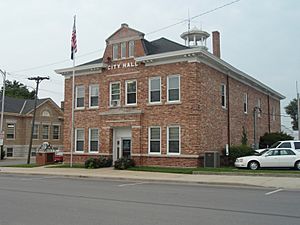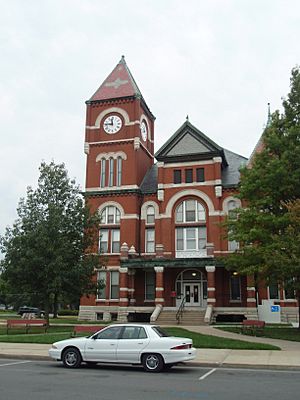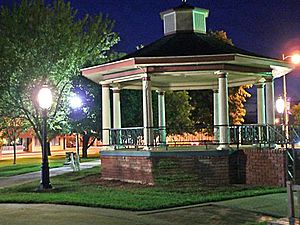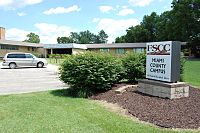Paola, Kansas facts for kids
Quick facts for kids
Paola, Kansas
|
|
|---|---|
|
City and County seat
|
|
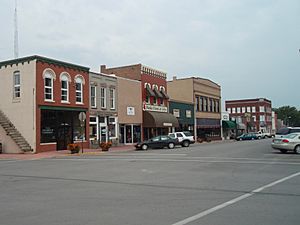
Downtown Paola (2009)
|
|
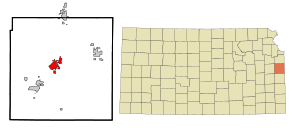
Location within Miami County and Kansas
|
|
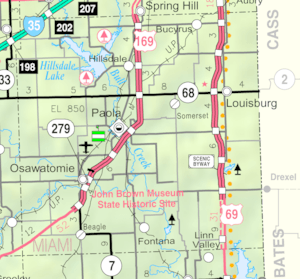
|
|
| Country | United States |
| State | Kansas |
| County | Miami |
| Incorporated | 1855 |
| Area | |
| • Total | 5.53 sq mi (14.33 km2) |
| • Land | 5.11 sq mi (13.24 km2) |
| • Water | 0.42 sq mi (1.09 km2) |
| Elevation | 906 ft (276 m) |
| Population
(2020)
|
|
| • Total | 5,768 |
| • Estimate
(2021)
|
5,786 |
| • Density | 1,043.0/sq mi (402.51/km2) |
| Time zone | UTC-6 (CST) |
| • Summer (DST) | UTC-5 (CDT) |
| ZIP code |
66071
|
| Area code | 913 |
| FIPS code | 20-54250 |
| GNIS ID | 485640 |
Paola (say "pay-OH-luh") is a city in Kansas, United States. It is the main city and county seat of Miami County. In 2020, about 5,768 people lived there.
Contents
History of Paola
Long ago, Native American tribes lived in the area where Paola is now. Later, Spanish explorers like Francisco Vásquez de Coronado visited in 1541. French missionaries also explored the land in 1673.
At the start of the 1800s, the Osage people mostly controlled this area. Between 1827 and 1832, other tribes like the Kaskaskia, Peoria, Wea, and Piankeshaw were asked to move here. They formed a group called the Confederated Allied Tribe.
Their leader was Baptiste Peoria, who had both French and Native American family. They named their village Peoria Village.
How Paola Got Its Name
By the 1840s, more European-American settlers moved into the area. Many missionaries lived near Peoria Village. One of them was an Italian priest, Father Paul D. Ponziglione, who arrived in 1852.
Father Ponziglione is known for renaming Peoria Village to Paola. He named it after a small town in Calabria, Italy. The Peoria Indians respected Father Ponziglione greatly, so they continued to call it Paola.
Growth and Early Days
By 1854, many settlers had arrived. A plan for the town was made in 1855. In the same year, the First Territorial Legislature officially created the Paola Town Company.
Baptiste Peoria and his wife, Mary Ann Isaacs, were very important in starting and growing Paola until the mid-1860s.
Paola During the Civil War
During the American Civil War, a military post was set up just west of Paola. Sometimes, soldiers were even inside the city. Paola was almost attacked on August 21, 1863, by a Confederate group led by William C. Quantrill. This happened when he was leaving after a raid on Lawrence.
Paola was also about 10 miles (16 km) west of where Confederate General Sterling Price's forces retreated on October 24, 1864. The military post in Paola closed in late 1865.
After the Civil War
After Kansas joined the United States in 1861, there was more pressure to move the Native American tribes. By 1868, most were moved to Oklahoma. Some individuals stayed and became U.S. citizens. However, their leader, Baptiste Peoria, left Paola with his tribe.
From the late 1860s through the 1870s, Paola grew a lot. It built its first school, jail, and bank.
Modern Developments
The railroad came to Paola in 1870, which helped the city grow even more. In 1882, natural gas was discovered. This made Paola the first town west of the Mississippi River to use natural gas for businesses and to light up the town with gas lanterns.
In 1898, the Miami County Courthouse was built. It was designed by architect George Washburn. He also designed other buildings and homes in Paola, including the Paola Park Square gazebo and the Paola Free Library. The library building was finished in 1906. Many of these buildings are still used today.
In 1912, James Patterson brought his circus, the Patterson Circus, to Paola for the winter. The circus ran until 1927. You can see a wall mural about the circus at 106 W. Peoria. The Patterson family home is still in Paola.
Paola Park Square
Paola's town center started as a gathering place for the Native American tribes. Before they moved to Oklahoma, Baptiste Peoria gave this area to the Paola Town Company as a peace agreement. The company later gave the square to the City of Paola, with the rule that no buildings could be built on it.
In 1867, the first gazebo was put on the square. It was used as a bandstand. In the 1800s, the square was also used for horse racing. It was a central spot for parades and other community events. In 1913, a new Victorian-style gazebo was built, designed by George Washburn.
Today, Paola Park Square is still used for community events. The 1913 gazebo is still there. Near it, you can find a statue of Paola founders Baptiste Peoria and his wife, Mary Ann Isaacs Dagenet. This is the only known monument in the United States that features a Native American and his wife. A fountain was also added to the center of the square.
Geography and Climate
Paola covers about 5.32 square miles (13.78 km2). Most of this area is land, with a small part being water.
Climate in Paola
Paola has a climate with hot, humid summers. The winters are usually mild to cool and dry. This type of weather is called a humid subtropical climate.
| Climate data for Paola, Kansas, 1991–2020 normals, extremes 1895–2009 | |||||||||||||
|---|---|---|---|---|---|---|---|---|---|---|---|---|---|
| Month | Jan | Feb | Mar | Apr | May | Jun | Jul | Aug | Sep | Oct | Nov | Dec | Year |
| Record high °F (°C) | 74 (23) |
82 (28) |
94 (34) |
92 (33) |
96 (36) |
106 (41) |
111 (44) |
109 (43) |
106 (41) |
96 (36) |
87 (31) |
72 (22) |
111 (44) |
| Mean daily maximum °F (°C) | 39.7 (4.3) |
45.3 (7.4) |
55.6 (13.1) |
65.8 (18.8) |
75.3 (24.1) |
83.9 (28.8) |
88.6 (31.4) |
87.1 (30.6) |
79.7 (26.5) |
68.6 (20.3) |
54.7 (12.6) |
42.7 (5.9) |
65.6 (18.7) |
| Daily mean °F (°C) | 29.3 (−1.5) |
34.3 (1.3) |
44.2 (6.8) |
54.6 (12.6) |
65.3 (18.5) |
74.4 (23.6) |
78.7 (25.9) |
76.7 (24.8) |
68.6 (20.3) |
56.7 (13.7) |
44.1 (6.7) |
32.9 (0.5) |
55.0 (12.8) |
| Mean daily minimum °F (°C) | 19.0 (−7.2) |
23.2 (−4.9) |
32.9 (0.5) |
43.4 (6.3) |
55.3 (12.9) |
64.8 (18.2) |
68.9 (20.5) |
66.2 (19.0) |
57.5 (14.2) |
44.8 (7.1) |
33.6 (0.9) |
23.1 (−4.9) |
44.4 (6.9) |
| Record low °F (°C) | −16 (−27) |
−22 (−30) |
−7 (−22) |
14 (−10) |
24 (−4) |
42 (6) |
47 (8) |
45 (7) |
28 (−2) |
19 (−7) |
3 (−16) |
−21 (−29) |
−22 (−30) |
| Average precipitation inches (mm) | 1.24 (31) |
1.68 (43) |
2.69 (68) |
3.84 (98) |
6.14 (156) |
5.22 (133) |
4.02 (102) |
4.33 (110) |
4.62 (117) |
3.42 (87) |
2.37 (60) |
1.79 (45) |
41.36 (1,050) |
| Average snowfall inches (cm) | 3.1 (7.9) |
3.5 (8.9) |
0.8 (2.0) |
0.1 (0.25) |
0.0 (0.0) |
0.0 (0.0) |
0.0 (0.0) |
0.0 (0.0) |
0.0 (0.0) |
0.1 (0.25) |
0.6 (1.5) |
3.2 (8.1) |
11.4 (28.9) |
| Average precipitation days (≥ 0.01 in) | 6.2 | 5.3 | 7.7 | 9.8 | 11.4 | 9.3 | 9.1 | 7.2 | 8.1 | 8.7 | 6.6 | 6.0 | 95.4 |
| Average snowy days (≥ 0.1 in) | 2.2 | 1.7 | 0.6 | 0.1 | 0.0 | 0.0 | 0.0 | 0.0 | 0.0 | 0.0 | 0.4 | 1.8 | 6.8 |
| Source 1: NOAA (snow/snow days 1981–2010) | |||||||||||||
| Source 2: National Weather Service | |||||||||||||
People of Paola
Paola is part of the larger Kansas City metropolitan area.
Population in 2020
In 2020, there were 5,768 people living in Paola. There were 2,396 households, which are groups of people living together.
Most people in Paola (about 88%) were White. About 2% were Black, and smaller numbers were Native American, Asian, or from other backgrounds. About 8% of the people were of two or more races. About 4% of the population was Hispanic or Latino.
- About 24% of the people were under 18 years old.
- The average age in Paola was about 40.5 years.
- For every 100 females, there were about 109 males.
Fun Things to Do in Paola
Paola is the biggest city in Miami County and its main center.
Every year, Paola hosts several fun events:
- The Miami County Fair in July.
- The Roots Festival in August.
- The Harvest Festival in October.
- A Christmas tree lighting after Thanksgiving.
You can also enjoy water activities and camping at Lake Miola. There is a modern Aquatic Center in Wallace Park. You can visit the Swan River Museum and the Miami County Historical and Genealogical Society. Many events are held at the Paola Community Center.
Education in Paola
Paola has public schools managed by the Paola USD 368 school district:
- Paola High School (grades 9-12)
- Paola Middle School (grades 6-8)
- Sunflower Elementary (grades 3-5)
- Cottonwood Elementary (Pre-Kindergarten-grade 2)
- Hillsdale Learning Center
Private Schools
- Holy Trinity Catholic School (Kindergarten-grade 8)
Colleges
- Fort Scott Community College has a campus in Paola.
Famous People from Paola
Some well-known people have connections to Paola:
- Olive Ann Beech: An important American aviation pioneer and businesswoman.
- Danny Carey: The drummer for the band Tool.
- John Conway: A State Senator in New Mexico and a United States Federal Judge.
- Lynn Dickey: A quarterback who played for Kansas State and in the NFL.
- Barney Graham: A scientist known for his work on vaccines.
- Stephen Johnson: A director of music videos.
- Steve Pepoon: A television writer.
- John Tibbetts: A film critic and historian.
- Justice Brothers: The people who started the Justice Brothers car care products company.
See also
 In Spanish: Paola (Kansas) para niños
In Spanish: Paola (Kansas) para niños


